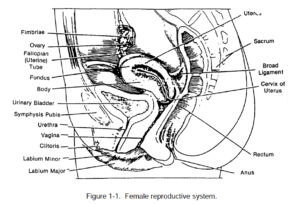The vulva and its parts make up the external genitalia.
The word vulva is a term that has been designated to stand for the external genitalia of the female.
a. Mons Pubis. The elevated, fatty tissue covered with coarse pubic hair which lies over the symphysis pubis is the mons pubis. Pubic hair appears at puberty. The function of the mons pubis is to protect the pelvic bone.
b. Labia Majora. The labia majora are large, longitudinal folds of skin and fatty tissue which extend back from the mons pubis to the anus. The outer surfaces are covered with hair. The inner surfaces are smooth and moist. The corresponding structure in the male is the scrotum. The function of these folds is to protect the entrance to the vagina.
c. Labia Minora. The labia minora are two folds of skin lying within the labia majora and also enclosing the vestibule. In front, each labium minus (minus = singular of minora) divides into two folds. The fold above the clitoris is called the prepuce of the clitoris. The fold below is the frenulum. No pubic hair is on these structures.
d. Clitoris. The clitoris is a small projection of sensitive, erectile tissue which corresponds to the male penis. The female urethra, however, does not pass through the clitoris. As in the male penis, the clitoris is covered by prepuce.
e. Urinary Meatus. The urinary meatus is the small opening of the urethra which is located between the clitoris and the vagina.
f. Vaginal Orifice. This is the opening to the vagina from the outside.
g. Bartholin’s Glands. These are bean-shaped glands located on each side of the vaginal orifice. They provide lubrication of the vagina.
h. Perineum. The perineum is the area between the vaginal orifice (opening) and the anus.

